Aah, the bathroom. Finally, you think, here's a room with simple storage needs. All a bathroom really requires is storage for towels and a few toiletries, right? Not anymore. The bathroom has voyaged light years beyond its outhouse days, when storage consisted of a nail for a fly swatter, and leagues beyond its 1950s days, when the whole family used the same bar of soap and bottle of shampoo.
Today's bathrooms require storage that is more diverse and specialized than baths of yore. For instance, today's master bathroom may contain a toilet, bidet, steam shower, whirlpool tub, two sinks, and a lounging area, all of which require storage systems.
Even standard bathrooms have storage needs beyond the towel-and-toiletry basics, in large part because toiletries aren't so basic anymore. A family of any size will need a storage spot for each member's favorite shampoo, soap, and scrubbing device, not to mention each person's personal grooming paraphernalia.
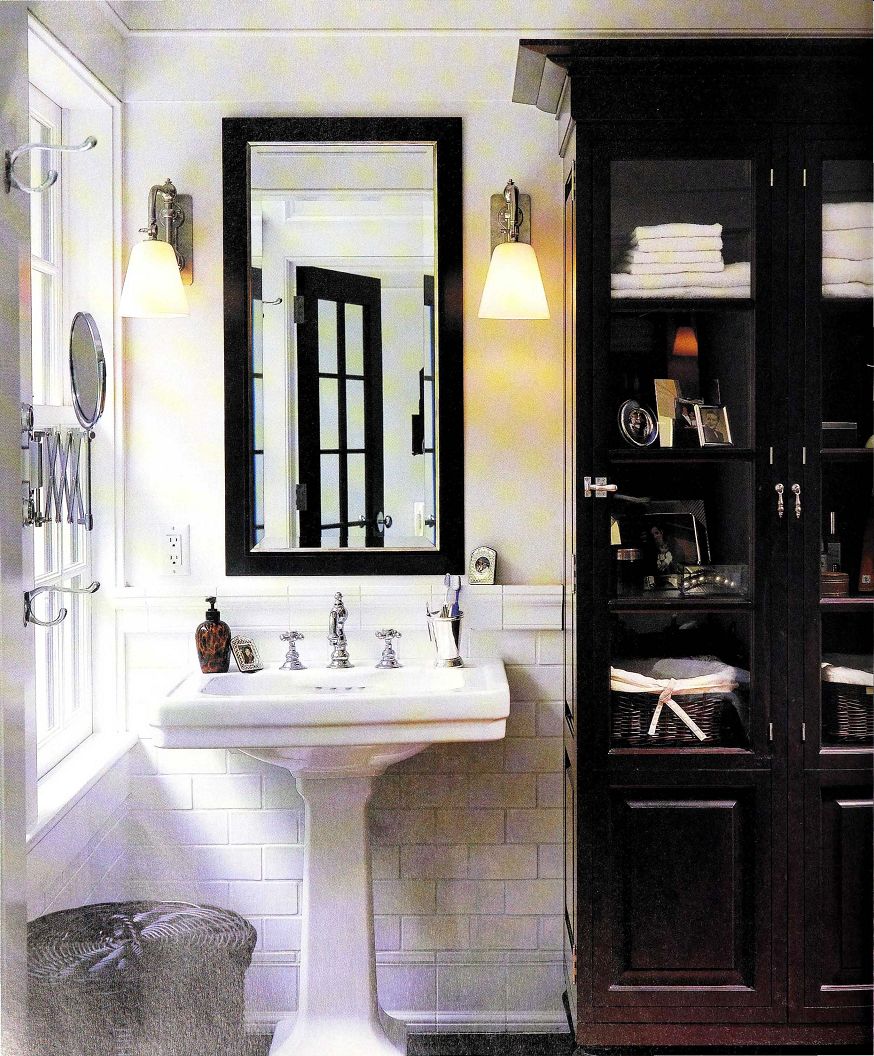
---------- This master bathroom avoids glitz and goes for elegance with
a rich and charming old-fashioned look. The lovely, dark-wood armoire protects
memorabilia from the steamy environment, while storing towels and bathroom
necessities. With in the cabinet, baskets further contain the clutter of toiletries.
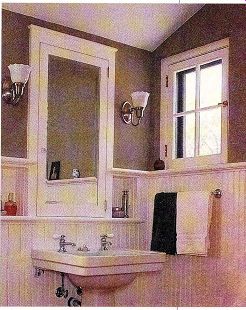
-------------- This bathroom makes use of nooks and ledges, as well as
a large medicine cabinet for the bulk of its toiletry storage.
Like its kitchen sister, the bathroom's myriad storage needs are best met with a wide range of storage options, from vanities to shelves to hooks and bars. As with the kitchen, the trick to effectively using limited space is figuring out what can be stored elsewhere-even if it's down the hall-and what must be kept close at hand .
Storage Areas to Consider
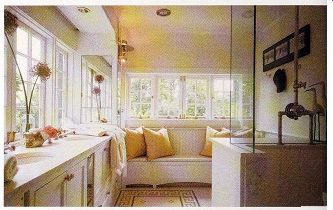
------------ This fresh and airy bath room keeps storage low so as not
to detract from the many windows. Along with storage under the sinks, the peaceful
window bench has compartments beneath the seat for backup towel storage.
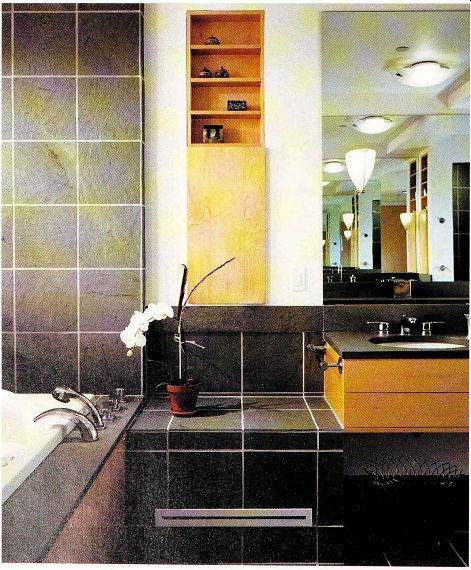
--------- This urban bathroom contains a wealth of storage in its streamlined
cabinetry.
The vanity has long, shallow drawers rather than cabinets, which helps tame toiletries, while the wall cabinet provides both open and concealed storage.
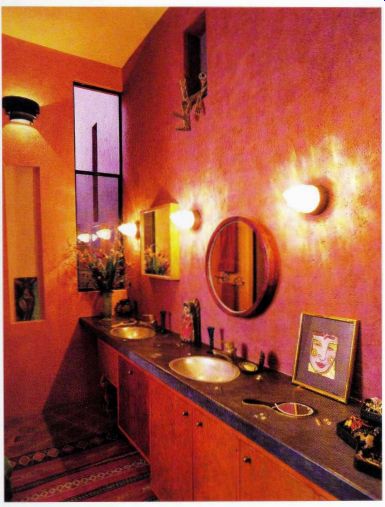
----------- The bathroom vanity in this Mexican house is a work of
art that's filled with art as well.
Every detail, from the beaded concrete countertop to the hammered metal sinks, adds another layer of beauty. But the art is fully functional here, providing abundant storage space for the less beautiful but still essential supplies that in habit a bathroom.
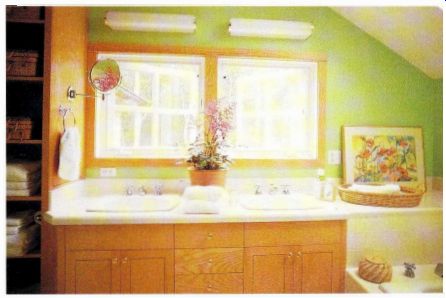
------------ Although modest in size, this bathroom finds the right balance
between aesthetics and practical storage . The vanity cabinets provide concealed
storage, while the open shelves make an attractive display of towel storage.
Backup toiletries are organized in covered boxes on upper shelves .
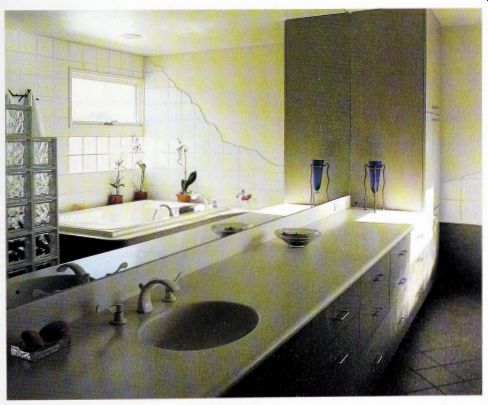
-------------- This spacious bathroom has more storage space than most
peoples' kitchens. The couple, whose kids have grown and moved out, even preferred
storage to an extra sink, so there are drawers aplenty-17 in all-in this bank
of frameless, plastic laminate cabinetry.
While most bathrooms are relatively small compared to other rooms in the house , they also tend to be more subdivided, with defined spaces for toilet, sink, and shower or bath. Whether or not these areas are actually partitioned off, each requires specific storage that should be customized as much as possible. When designing storage, consider the way your family uses the bathroom. For instance, take a shower with storage in mind to help you discern what's lacking: Are there too many bottles and are they constantly slipping onto the shower Door? Is there a hook or bar close at hand to hang washcloths and towels? Where can you spread out a damp towel or bath mat to dry? Applying this step-by-step analysis to every part of the bathroom will help clarify your particular storage needs and how to accommodate them.
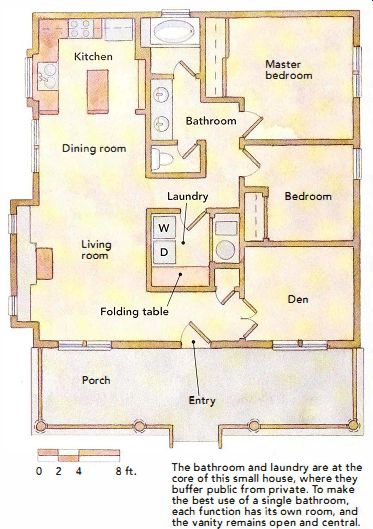
--------- Maximizing a Small Bathroom: The bathroom and laundry are at
the core of this small house, where they buffer public from private. To make
the best use of a single bathroom, each function has its own room, and the
vanity remains open and central.
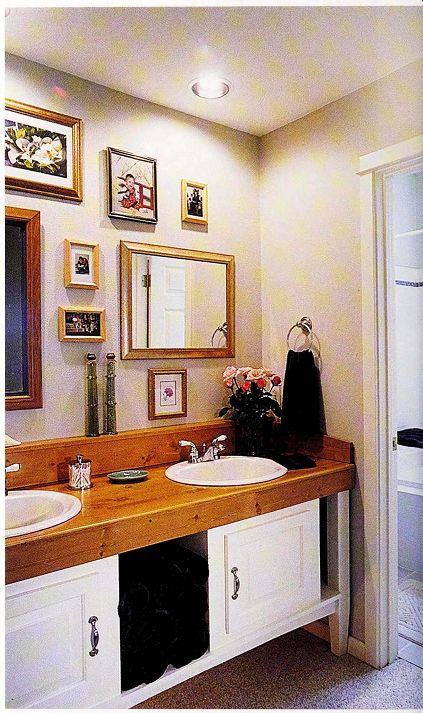
----------- In a very tight house-1 ,048 sq. ft. for a young family
of three-dividing bathroom functions makes the most sense (see the floor plan
at left). The shower, vanity, and toilet each have separate but connected areas,
allowing multiple occupants space and privacy. Of course, two sinks are a necessity,
as are two mirrors and centralized towel storage. The washer and dryer are
just across the hall from the bathroom suite.
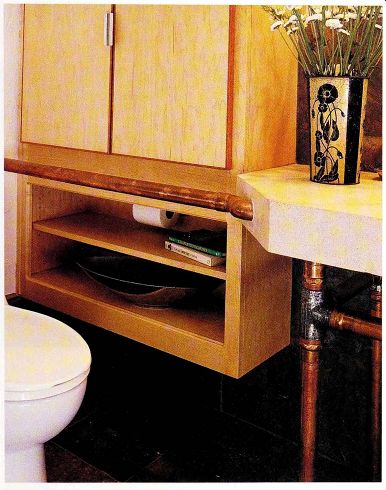
------------ Especially in a small bathroom, the usually dead wall space
around a toilet alcove may be the perfect location for cabinetry-accessible
but out of the way.
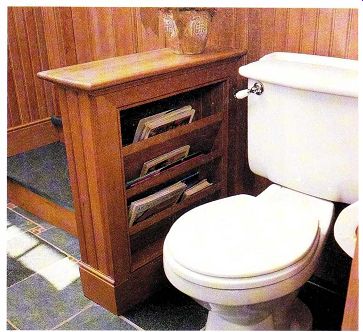
------------ Bleached-cherry V-groove bead-board creates a handsome, hardworking
surface for a bathroom located near the family pool; the half-height wall with
slots for reading material provides a little extra privacy and the perfect
excuse to escape for a few minutes of un interrupted reading.
The Toilet
The toilet requires less storage than other bathroom areas, but it's very important storage-keeping extra toilet paper in the linen closet down the hall just doesn't cut it. Along with a niche for backup rolls, which could be a basket, ledge, shelf, or cabinet, it's ideal to keep toilet brush and cleanser nearby but tucked out of sight. A base cabinet would be ideal. Reading material is a traditional accompaniment, but careful placement is crucial-especially if little boys share the bathroom. A basket or magazine rack is fine as long as it's out of the way, but it does tend to collect dust and dirt.
Hanging a rack on the wall near the toilet may be a better alternative , or books and magazines can be staked on a shelf above the toilet. If your toilet is joined by a bidet, storage will be needed for soap and towels that are within easy reach.
The Sink
Consider all the activities we perform sink-side: washing, shaving, brushing, applying makeup, cleaning cuts and scrapes, soaking lingerie, and sometimes even washing hair and babies. The sin k requires storage space for each of these tasks: towels, washcloths, soap, fingernail brushes, shaving gear, mouthwash, makeup, cotton balls, toothpaste, toothbrushes, first-aid supplies, and all the mentionable and unmentionable toiletries we acquire. Make it easy to store and retrieve these bathroom essentials, whether in closed cupboards, open shelves, or in a mix of deep and shallow drawers. A traditional sink vanity can handle a good portion of bathroom storage, but it can become a hindrance rather than a help if too much stuff gets tossed together randomly.
Baskets, boxes, and caddies can help keep items contained within vanity closets and drawers. If you can't resist the beautiful lines of a pedestal sink, just keep in mind how much storage a vanity handles and make sure you have enough auxiliary storage-in the form of freestanding furniture and shelves-to compensate.
The Shower and Tub
Many master bathrooms feature both a shower and a tub.
Each requires a nearby shelf, hook, or bar for a towel and washcloth or loofah; even if you opt for a shelf or hook, you'll need a bar to hang damp items, including the bath mat. A hook for a bathrobe is a nice addition, as is a place to hang clothes-either those you remove or those you'll be putting on (that steamy atmosphere can help smooth wrinkles on clothes, if not on your face). Each bathing space should contain a hamper, preferably a well-ventilated one, as well. If you have the space, you could even include more than one to sort laundry at the source.
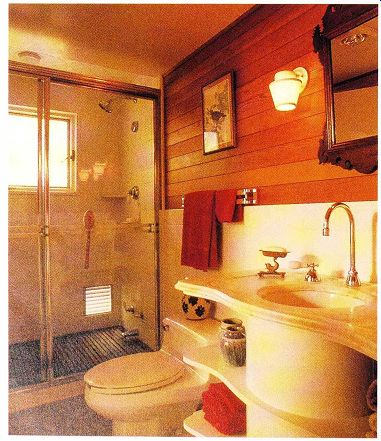
------------- This bathroom may have the standard tub-toilet-sink layout,
but its sink is quite out of the ordinary. It's supported by a cylindrical
pedestal that sprouts several tiers of shelves.
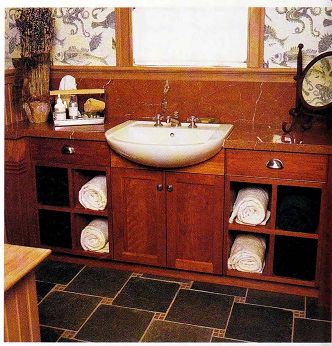
-------------- A space-saving (and visually interesting) solution in this
narrow bathroom was to keep the vanity shallow and al low the sink to extend
past its boundary. Cubbies beneath keep extra beach towels within reach of
the pool. The tile floor makes for quick cleanup.
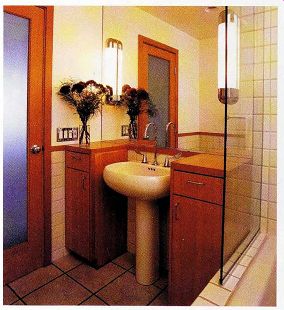
---------- A pedestal sink can be the perfect streamlined appliance for
a small bath room, but it doesn't offer storage space. The elegant solution
here is two small, freestanding cabinets built from Douglas fir.
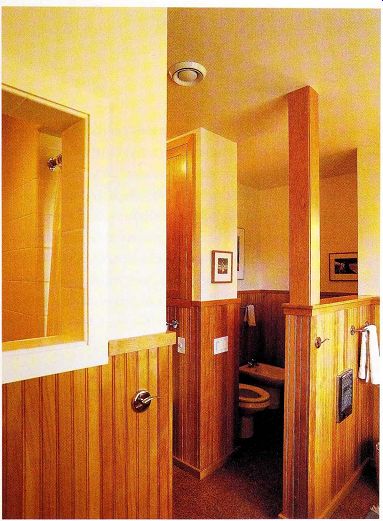
----------- In this master bathroom, beaded hemlock wainscoting provides
an easy-to-maintain, traditional look. The half walls of wainscot define various
stations in the bathroom, creating a sense of privacy while al so providing
natural shelving. Hooks and bars are scattered throughout for towels and robes.
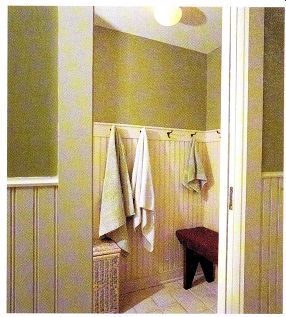
---------------- This casual shower area has lots of hooks to accommodate
a big family. The bench offers a place to set clothes or robes, and a hamper
keeps the small space tidy. Because the shower is in its own separate alcove,
multiple family members can use the bathroom at the same time.
Finding Space for Bathrooms in an Old House
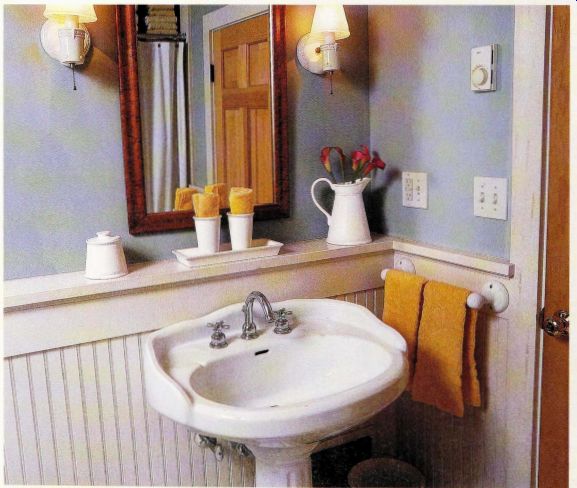
---------- Thick wainscoting not only makes room for plumbing but its wide
cap creates a handy ledge for toiletries, too.
Storage space is always hard to come by naturally in a 19th-century house, but finding bathroom storage can be impossible because back then, there was no such thing as an indoor bathroom. This house, first built as a one-room cottage in 1820, grew slowly over the years (in the late 1800s, one room was used as a ticket office for the commuter railroad, which still runs behind the house), but not enough to have a decent working bathroom.
Eventually, space was carved out to make a bath room upstairs, but by the late 1980s, when architects Rick and Liz O'Leary purchased the house, it needed a serious remodel. After reframing the bath room, Rick and Liz installed a standard 5-ft. bathtub (that's where their preschool boys are given baths) . The 18-in. space left over was dedicated to a built-in column of narrow but deep shelves, which are used for towel storage (two stacks deep) and backup toiletries.
Just outside the bathroom on the stair landing, a hybrid cupboard stores linens for bath, bed, and table. Starting with a flea-market chest of drawers, Rick added pine sides, stiles, rails, and shelves and painted the whole assembly.
The only way to fit a bathroom downstairs was to square off an inside corner of the house. The new wall was built up and finished off with wainscoting to conceal plumbing, which also created a thick ledge that's well suited for toiletry storage. No space goes unused in this bathroom; it somehow manages to fit a 3-ft.-sq. shower flanked by a stacked washer/dryer unit.
The space above is maximized by a deep shelf for towels.

----------- A There's just enough room in the bathroom for a stacked washer/dryer
unit-the shelf above offers extra linen storage. A shower curtain in front
plays off the bathroom theme while hiding the unit when not in use.
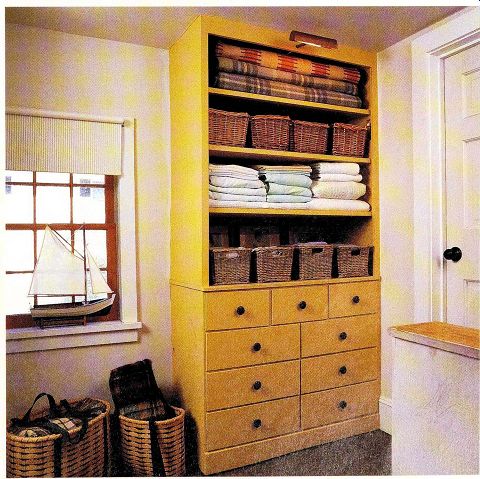
-------------- A This freestanding, hybrid cupboard is located just outside
the bathroom on the stair landing, providing handy storage for towels, sheets,
and even tablecloths. The drawers could be used for extra or seldom-used toiletries
and grooming appliances.
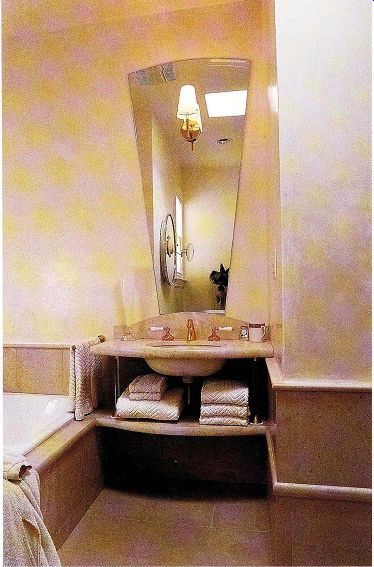
------------- This master bath in a city apartment has lovely tall ceilings
but not a lot of floor area . Rather than filling the limited space with a
vanity, the homeowners opted for a sink with open shelves below, creating convenient
and streamlined towel storage that is easily accessed from the tub. Where the
toiletries are stashed is anyone's guess.
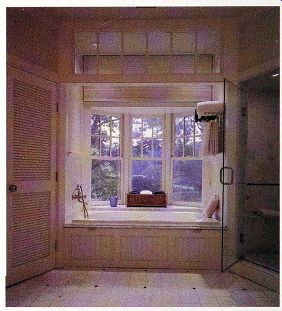
---------- This unique tub alcove keeps bathing apparatus at hand. A towel
rack and basket keep linens and robes right where they're needed, while the
window ledge makes room for bath oils and soaps. The adjacent closet offers
more abundant and private storage.
A well -designed shower or tub will include plenty of flat surfaces within for storing shampoo, bath oils, soap, and other bath needs. If you're building or remodeling, consider a generous tub surrounded with thick ledges or multiple niches built into the tile; otherwise, there's a variety of caddies available that either hook over the showerhead or hang in the corner. Caddies, particularly wire models, offer the advantage of easy draining and drying, which will help foil mold. Pocketed shower curtains look snappy and seem handy, but they can be prone to mildew. If space in the shower is tight or it's shared by a large family, portable caddies, which can be stored under the sink or in a closet, may be a good alternative to permanent shower storage.
Storing Toiletries and Medicine
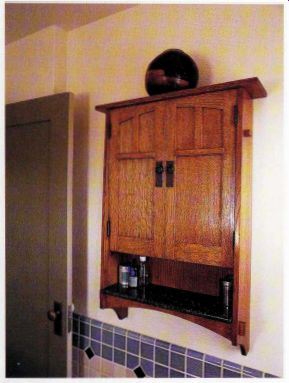
------------- A matching oak medicine cabinet has both concealed and open
space, allowing everyday items to be easily accessed and less frequently used
(or more personal) items to be stored inside and out of the way.
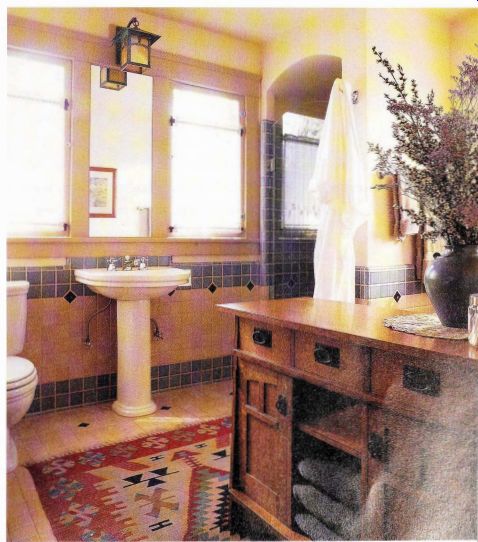
--------- To reinforce the Arts and Crafts style of their 1919 house, these
homeowners replaced a style-less, built- in vanity with this pedestal sink
and Craftsman-style cabinet built from quartersawn oak. Its drawers contain
toiletries, while the shelves below make a convenient linen closet.
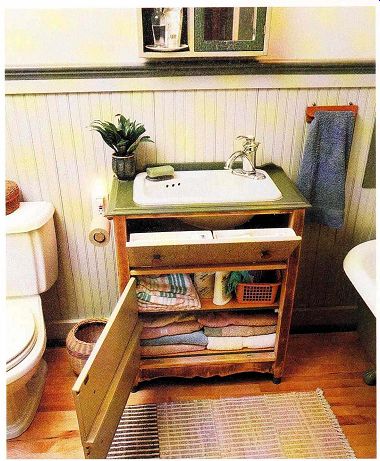
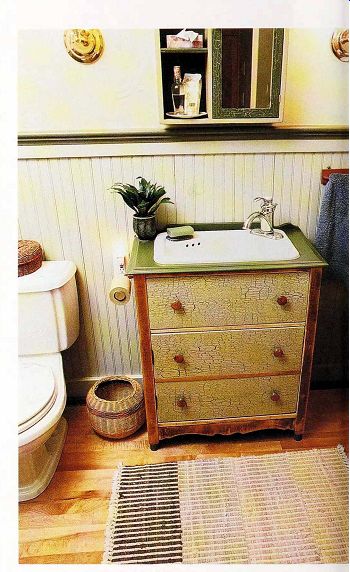
-------------- A little chest of drawers was given new life as a vanity
by removing the drawer boxes to make room for the sink bowl and plumbing. The
top drawer fronts were reattached with a bottom hinge; two small trays were
installed on the panel to hold toothbrushes. The lower two drawer fronts became
a cabinet drawer that conceals linens and a caddy of toiletries.
Toiletries can be loosely defined as all those bottles, tubes, and tools that we use to keep ourselves clean and looking good. Like cereals and flavors of yogurt, everyone has favorites. A family of four may very well use four--or more--different types of shampoo, while a teenager with rampant hormones requires a different kind of face cleanser than his dry-skinned mom.
Like the kitchen, the bathroom may have far more paraphernalia than it has storage space , in which case , off-site storage may need to be employed. Toiletries that are used daily should be kept in the bathroom, but the bathroom equivalent of pantry storage can be devised for backup items and less frequently used toiletries, such as masques or hair coloring. The linen closet has been a traditional warehouse for toiletry storage, but items tend to get lost on its deep shelves; consider installing a vertical column of narrow shelves on one wall of the closet, which will help keep order. If you're building or remodeling, look at pantry design for inspiration and consider including a shallow closet specifically dedicated to toiletry storage.
The Vanity
The traditional, built-in vanity is slightly shorter (32 in. as opposed lo 36 in.) and often more shallow than the standard 2-fl. -deep kitchen cabinet. Like the kitchen cabinet, however, vanity cabinet cases and doors are most often built from plywood or medium-density fiberboard (MDF) that's been given a wood-veneer, plastic-laminate, or melamine finish.
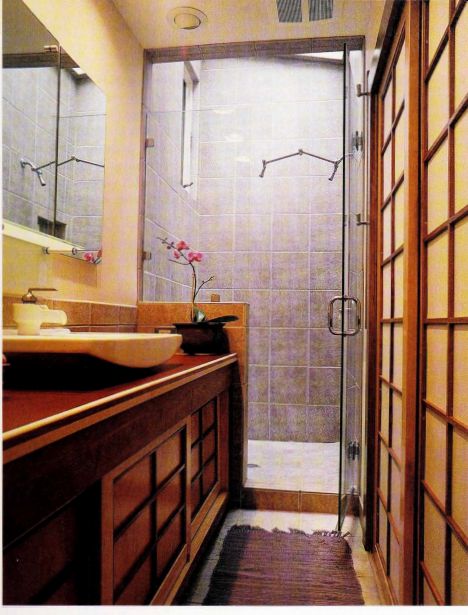
---------- This 21-in. -deep vanity has space-saving sliding doors, which
make an aesthetic statement, while keeping this very narrow bathroom maneuverable.
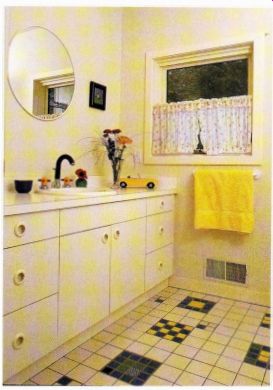
---------- This cheerful bathroom belongs to an artist who has added spark
to this straightforward bathroom with fanciful touches such as the tiled floor
and bold sink fixtures. Even the standard (but highly efficient), off-the-shelf
vanity has been given an artsy, modern flare with circular finger pulls in
place of traditional hardware.
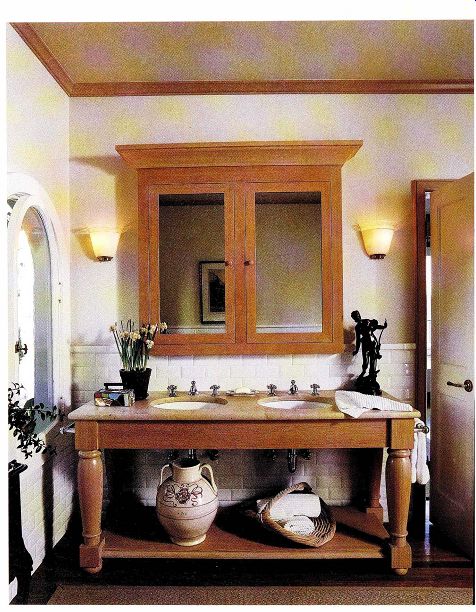
------------ A chunky, English-style table makes a big statement as a vanity,
with two sink bowls set into the marble countertop. The apron is so deep that
it hides the sink bowls and most of the plumbing from view, while still providing
room for storage and display. A medicine cabinet with substantial crown molding
balances the table's heft and provides lots of storage.
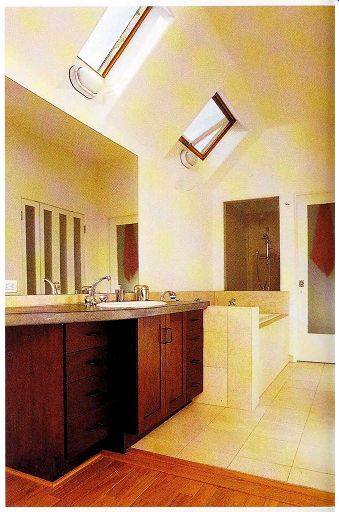
----------- This vanity ingeniously unites the master bedroom and bath
suite, bridging the gap between the wood floor of the former and limestone
tile of the latter. The unique design of its drawers and cabinets further defines
space and function: Once they hit the limestone, they jut out from the section
of vanity that resides on the bedroom side of the borderline. The vanity's
concrete countertop follows suit, curving out from the wall to attach to the
end of the tub.
Some face-frames are built from solid wood. And bathroom cabinets are no less blessed than their kitchen cousins with any number of stock or custom-designed inserts and configurations that will help you corral toiletries. A vanity doesn't have to be built-in, however. A freestanding table, chest, or waist-high shelf unit can stand in for the traditional vanity cabinet, even to the extent of containing the sink and its plumbing.
A vanity can be fitted with an assortment or drawers, doors, and even open shelving, depending on what kind or toiletries you plan to store there. Whatever configuration you chose, include substantial closed cabinetry--drawers and doors--which is essential in a bathroom. Shallow drawers work best for makeup and smaller grooming products, but partitions, boxes, baskets, or caddies can help tame small toiletries in a larger drawer. Drawers that will be used for active toiletry storage should be positioned just to the side or a sink or between two sinks for easiest accessibility.
Shelves are also useful in a vanity. Pullout shelves are almost as easy to access as drawers and make a good supplement to drawer storage for toiletries that are used daily.
Fixed shelving works well for backup or infrequently used toiletries. Open shelves and ledges can be an aesthetically pleasing addition to vanity configurations and are perfect for toiletries that are pretty and colorful (as well as handy to have right at hand) , such as perfume, makeup brushes, or decorative jars that hold cotton swabs or cotton balls.
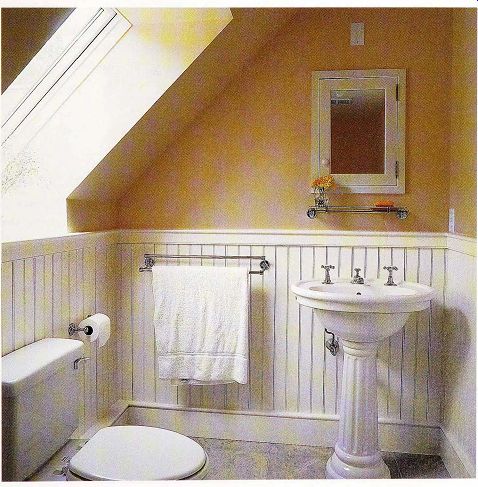
------------ A bathroom under the eaves is a cozy and bright space with
the addition of a skylight. A small medicine cabinet and a single glass shelf
provide storage for bathroom basics, which is all that is needed in this secondary
half-bath.
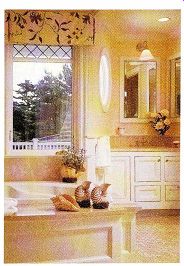
------------- In this master bathroom, drawers and cabinets provide a
good mix of storage, while a medicine cabinet (behind the side mirror) makes
everyday items easy to reach.
The Medicine Cabinet
A traditional in-wall medicine cabinet is not a necessity if there's sufficient storage in vanity drawers, on linen closet shelves, or in countertop caddies. But there's something to be said for the naturally restricted space of a recessed medicine cabinet, with its shallow, removable, easy- to-keep-clean glass shelves, and its high placement-usually a deterrent to small children. Yet medicine cabinets aren't always the best bet for storing medicines. The bathroom is not the cool, dry place that most medicines require for storage, and many medicine cabinets aren't lockable.
The medicine cabinet is ideal for small toiletries that you use every day--a razor, nail scissors, cotton balls, alcohol , and basic cosmetics. Provide narrow, open containers, such as a soap dish , to collect the stuff that tends to roll or tip out. Or copy the design in your refrigerator door and provide a little lip or railing on the edge of the shelves. Don't store occasionally used toiletries here; relegate them to a linen closet or vanity along with back-stock toiletries. While mirrors make natural doors for medicine cabinets that hang over a sink, there's no reason you can't put a medicine cabinet to one side and give it a glazed or solid door.
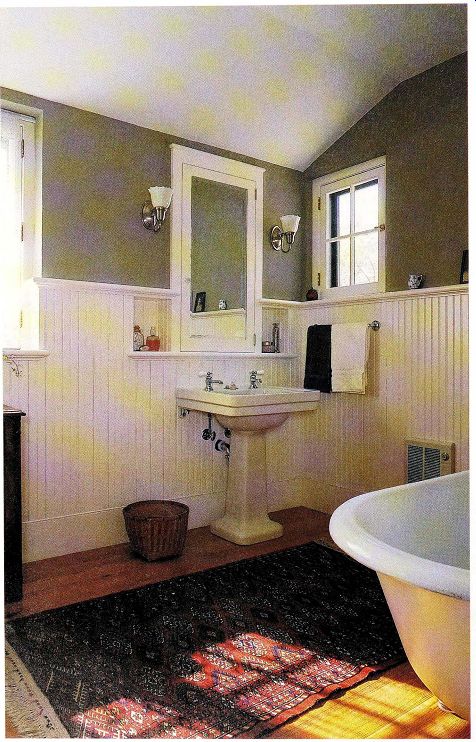
--------- A recessed medicine cabinet is just one of the details that helps
this new house look old. The pedestal sink is an authentic addition, but it's
behind the times in terms of storage.
However , the medicine cabinet and wainscoting niches provide enough room for everyday toiletries .
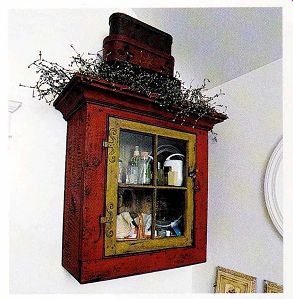
--------- The new master bathroom in this old house shows off a rustic
medicine cabinet built from salvaged barn lumber, complete with an old barn
window.
=============
Childproof Storage
In families with small children, it's essential that any medicines, prescription or over-the-counter, are stored up high in lockable cabinets or closets. And it's not just medicine that's potentially dangerous to young children. Many adult toiletries, most first-aid treatments, and certainly cleaning materials are potentially toxic.
It's so much easier to keep a bathroom clean if cleaning materials are kept there as well, but it's more important to keep them out of reach of small children. Install truly childproof locks (not the easily breached plastic clips that fit on the inside) on cabinets that contain dangerous materials.
==============
Storing Bath room Linens
The linen closet doesn't have to be a 2-ft. -by-2-ft. alcove with a door. A tall built-in cabinet, a freestanding hutch or armoire, or open-shelf units are all good storage alternatives for towels, washcloths, and toilet paper. Regardless of where you store them, towels should be rotated to prevent uneven fading.
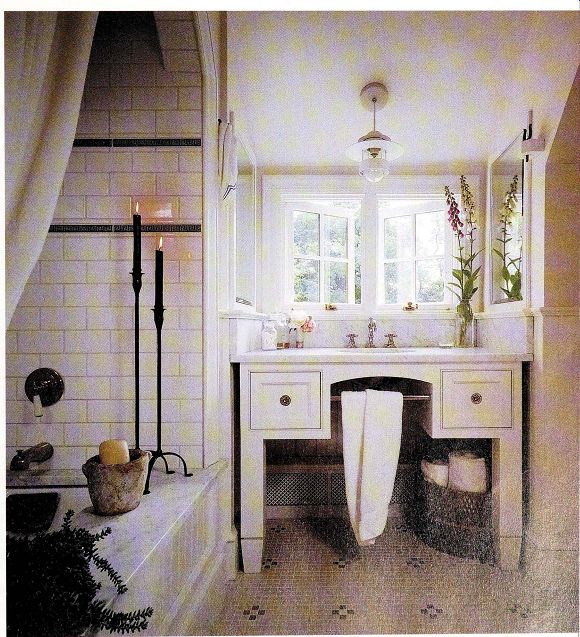
---------------- This lovely but modest sized bathroom provides simple
but varied storage for towels-on a stainless steel rod under the sink, in a
basket under the vanity, and in built-in cubbies trimmed with a beaded edge.
While the latter provides back- up storage, this quaint basket can be pulled
over to the bathtub, allowing the bather to pull a fresh towel without dripping
all over the floor.
Storage That Moves: Carts and Caddies
Portable containers for toiletries and towels make a lot of sense in a bathroom, particularly when it has multiple users and limited space. Divvy up toiletries by family member so that everyone has the day's toiletries at hand in one basket, which can be carted from closet to sink to shower. Or sort toiletries by type and designate a shower-bound caddy and a sink side one.
A rolling cart can be a very efficient storage option as well. Like caddies, a cart will al low you to stash paraphernalia out of the way while still keeping it accessible. But with a cart, the entire spectrum of your grooming needs-towels, toiletries, and even appliances-ca n be kept in one convenient place.
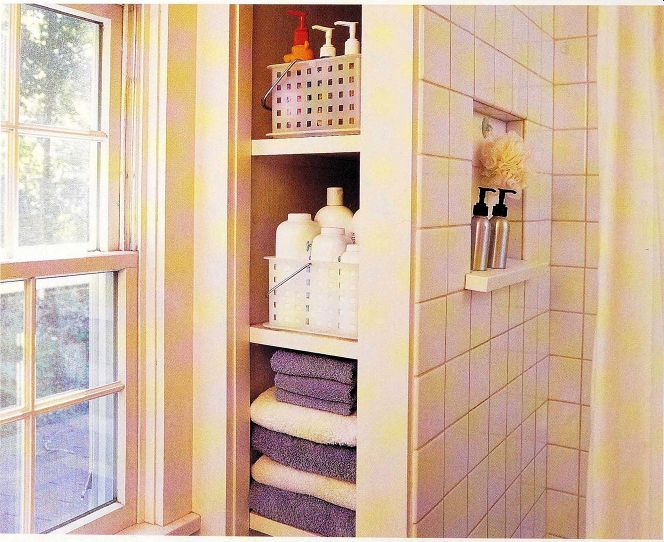
-------------- Plastic caddies hold everyday toiletries in this small bathroom,
making them a breeze to cart to sink or tub and then put back in the linen
closet when grooming is done.
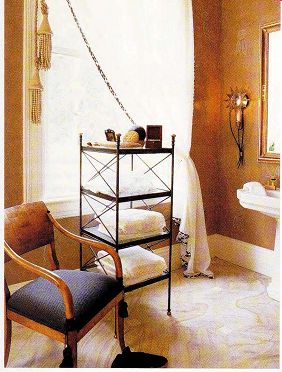
------------- This lovely urban bathroom has lighter-than-air storage
in the form of a delicate rack for towels and toiletries. Keeping storage light
helps make the space feel bigger.
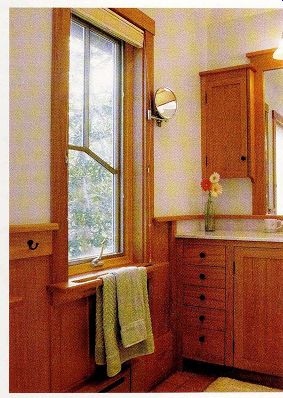
---------- The windowsill in this Martha's Vineyard house was widened and
fitted with a 2-in .-wide slot, which functions as a towel rack. Hooks in the
wainscoting trim are handy for additional towels, robes, and clothing.
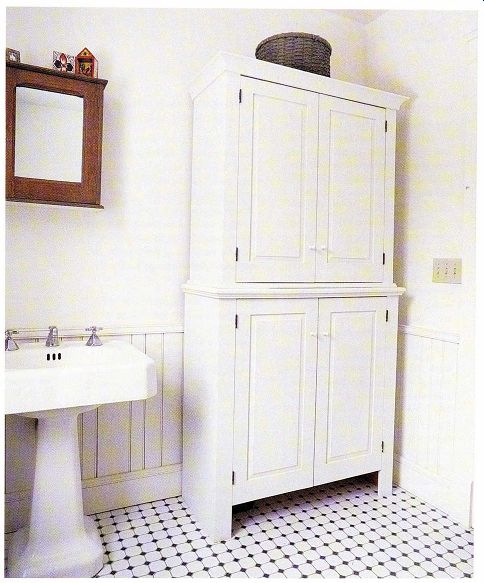
--------------- This pine linen cabinet was inspired by the simplicity
of early American furniture. It provided enough room for towels and toiletries
so that the homeowners could sacrifice a vanity for a traditional pedestal
sink.
Have you ever been in a bathroom with too many towel bars and hooks? Probably not. It never hurts to install more towel bars than you think you'll need, although finding the space for them may be tough. Be inventive: Recess the front of a vanity and install a wide towel bar just below the countertop. And don't ignore the back of the door: Two towel bars can fit here, as can a peg rail with hooks for towels or bathrobes.